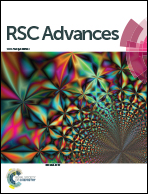Facile synthesis of porous Fe3O4@C core/shell nanorod/graphene for improving microwave absorption properties†
Abstract
Porous Fe3O4@C core/shell nanorods decorated with reduced graphene oxide (RGO) were fabricated through a facile one-pot method. The microwave absorption properties of the samples can be adjusted by the weight ratio of RGO. The addition of RGO not only effectively reduces the agglomeration of Fe3O4@C, but also has a great effect on impedance matching and dielectric loss, resulting in enhanced microwave absorption abilities. The thickness corresponding to optimum reflection loss (RL) decreases as the weight ratio of RGO increases. For the Fe3O4@C/RGO composite, a maximum RL value of −48.6 dB can be obtained at 13.9 GHz with a thickness of 3.0 mm, and the absorption bandwidth with RL below −10 dB is 7.1 GHz from 10.9 GHz to 18 GHz. These results demonstrate a facile method to prepare a highly efficient microwave absorption material with special microstructure.



 Please wait while we load your content...
Please wait while we load your content...